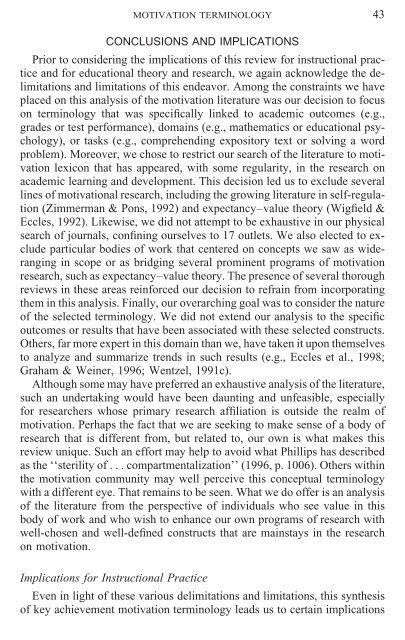A Motivated Exploration of Motivation Terminology - Anitacrawley.net
A Motivated Exploration of Motivation Terminology - Anitacrawley.net
A Motivated Exploration of Motivation Terminology - Anitacrawley.net
Create successful ePaper yourself
Turn your PDF publications into a flip-book with our unique Google optimized e-Paper software.
MOTIVATION TERMINOLOGY 43CONCLUSIONS AND IMPLICATIONSPrior to considering the implications <strong>of</strong> this review for instructional practiceand for educational theory and research, we again acknowledge the delimitationsand limitations <strong>of</strong> this endeavor. Among the constraints we haveplaced on this analysis <strong>of</strong> the motivation literature was our decision to focuson terminology that was specifically linked to academic outcomes (e.g.,grades or test performance), domains (e.g., mathematics or educational psychology),or tasks (e.g., comprehending expository text or solving a wordproblem). Moreover, we chose to restrict our search <strong>of</strong> the literature to motivationlexicon that has appeared, with some regularity, in the research onacademic learning and development. This decision led us to exclude severallines <strong>of</strong> motivational research, including the growing literature in self-regulation(Zimmerman & Pons, 1992) and expectancy–value theory (Wigfield &Eccles, 1992). Likewise, we did not attempt to be exhaustive in our physicalsearch <strong>of</strong> journals, confining ourselves to 17 outlets. We also elected to excludeparticular bodies <strong>of</strong> work that centered on concepts we saw as widerangingin scope or as bridging several prominent programs <strong>of</strong> motivationresearch, such as expectancy–value theory. The presence <strong>of</strong> several thoroughreviews in these areas reinforced our decision to refrain from incorporatingthem in this analysis. Finally, our overarching goal was to consider the nature<strong>of</strong> the selected terminology. We did not extend our analysis to the specificoutcomes or results that have been associated with these selected constructs.Others, far more expert in this domain than we, have taken it upon themselvesto analyze and summarize trends in such results (e.g., Eccles et al., 1998;Graham & Weiner, 1996; Wentzel, 1991c).Although some may have preferred an exhaustive analysis <strong>of</strong> the literature,such an undertaking would have been daunting and unfeasible, especiallyfor researchers whose primary research affiliation is outside the realm <strong>of</strong>motivation. Perhaps the fact that we are seeking to make sense <strong>of</strong> a body <strong>of</strong>research that is different from, but related to, our own is what makes thisreview unique. Such an effort may help to avoid what Phillips has describedas the ‘‘sterility <strong>of</strong> . . . compartmentalization’’ (1996, p. 1006). Others withinthe motivation community may well perceive this conceptual terminologywith a different eye. That remains to be seen. What we do <strong>of</strong>fer is an analysis<strong>of</strong> the literature from the perspective <strong>of</strong> individuals who see value in thisbody <strong>of</strong> work and who wish to enhance our own programs <strong>of</strong> research withwell-chosen and well-defined constructs that are mainstays in the researchon motivation.Implications for Instructional PracticeEven in light <strong>of</strong> these various delimitations and limitations, this synthesis<strong>of</strong> key achievement motivation terminology leads us to certain implications
















